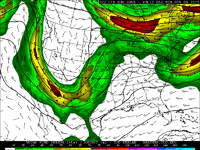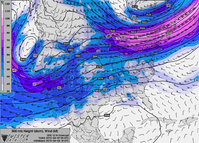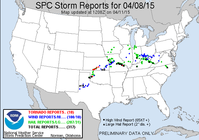Time to revisit this thread. We had an interesting week of severe weather events, but it looks to be quiet for at least a few days now, so we have some time to sit down and evaluate the upcoming few weeks for the next threats.
We seem to be in a period of low synoptic scale predictability or just overall forecast jumpiness. Recent GFS runs have been all over the place regarding a cutoff low and eventual shortwave trough that becomes embedded within the sub-tropical jet later this week. Looks like Dixie Alley may see its first solid severe weather setup this week (although currently the details suggest the severe threat may not be on the high end like we seem to see around this time of year). There was quite a shift in the location of the cutoff between the 00Z and 12Z runs today, too, so it's a little hard to know for sure what to expect this week, other than it looks like the southern plains and southeast are going to get a drought-reducing amount of rain (when considering the amount that has fallen in the region the past few days).
After that, however, it looks kind of sad. It looks like a strong eastern US trough will form with quite low heights later in the forecast period, which will likely spill a cP air mass all over the eastern half of the country. It also appears this trough may clean out the Gulf of moisture.
Now for the good: rain, and lots of it. The southern plains has been getting a lot of rain lately. This will do wonders to keep the area from starting to bake early on once May rolls around. The rain will also help keep soil moisture up and will help with green-up so that future disturbances may give more moisture (recall the system this past week had pretty good moisture to work with: mid-upper 60s dews in early April is pretty decent if you ask me). It looks like there will be more to be had this next week, as the 7-day WPC rain forecast (see below) suggests over 2" may fall across much of OK and parts of TX as well. Even drier areas to the west look to get in on some of the action.
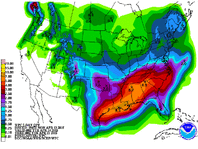
CPC agrees and has wet anomaly probabilities for the southern/southwest US over the next two weeks:
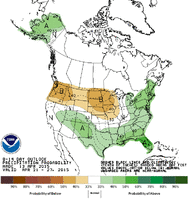
It's never fun to see an extended hiatus from severe weather after an active week early in the season, but hope is high that we have many good weeks of chaseable severe weather ahead of us this year. While the predicted 500 mb height anomalies from recent CFS runs are a little conflicting (both positive and negative anomalies west of the central US, see below), the forecast for below normal heights in the southern latitudes could be an indication of southern stream troughs coming through more often.
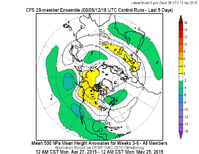
Lastly, the CFS had a pretty good signal for this past week's severe weather when you look at the charts Greg Carbin has put together (
http://wxvu.net/spc/cfs_scp/). Looks like it still only picks up a solid signal once something is in the 8-12 day range, so don't get too concerned about the lack of "hot" boxes showing up down the line. It may not mean anything.



